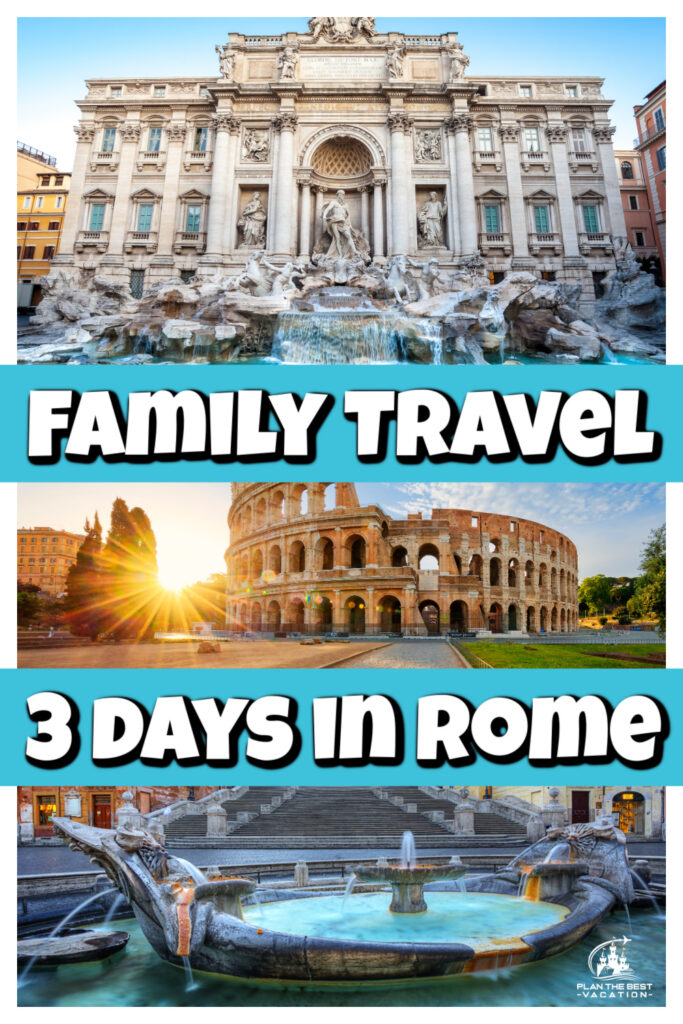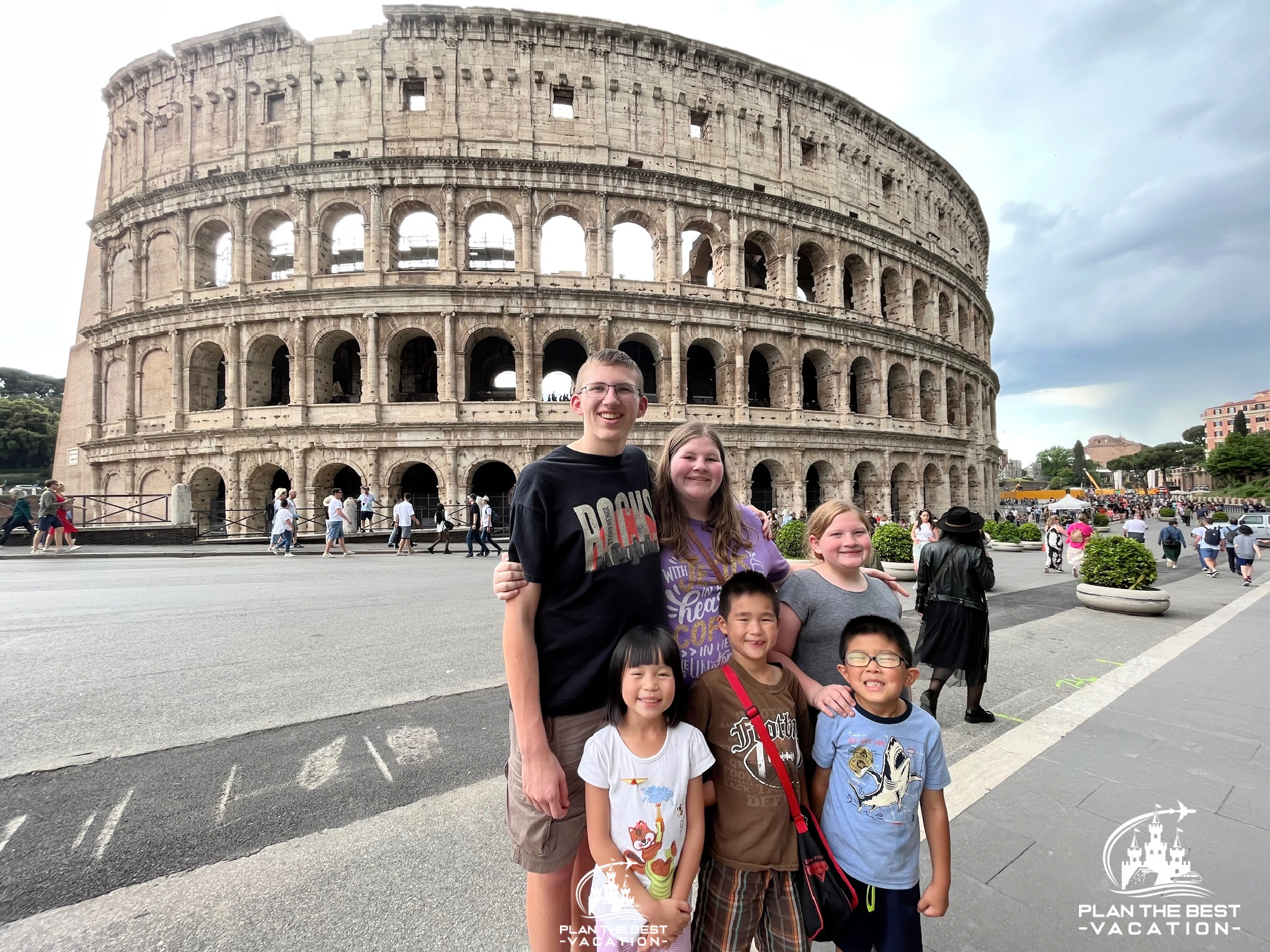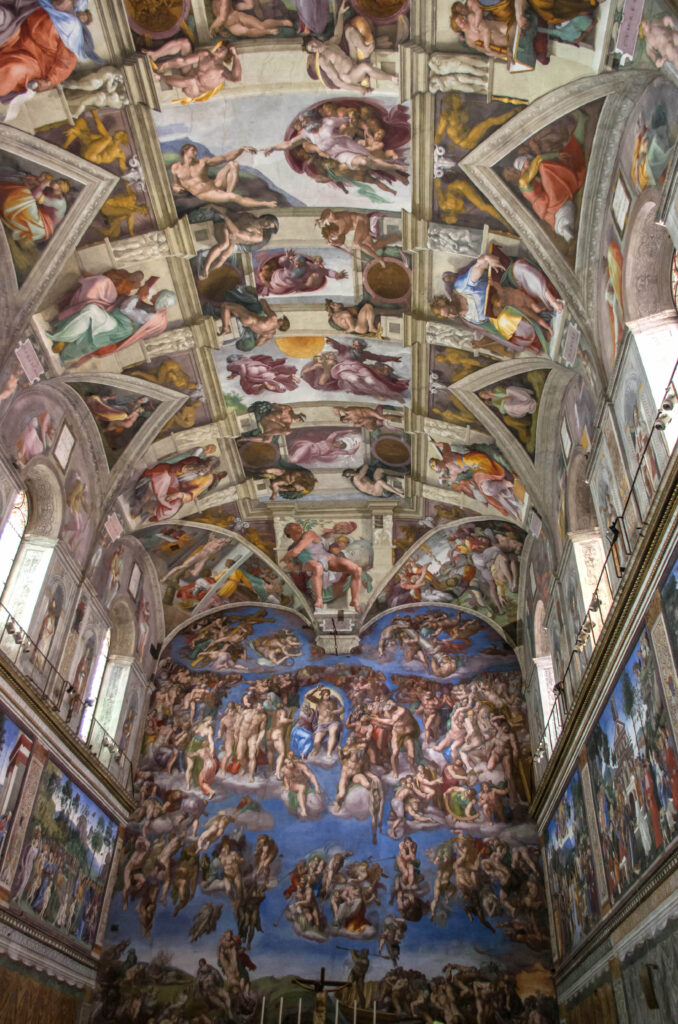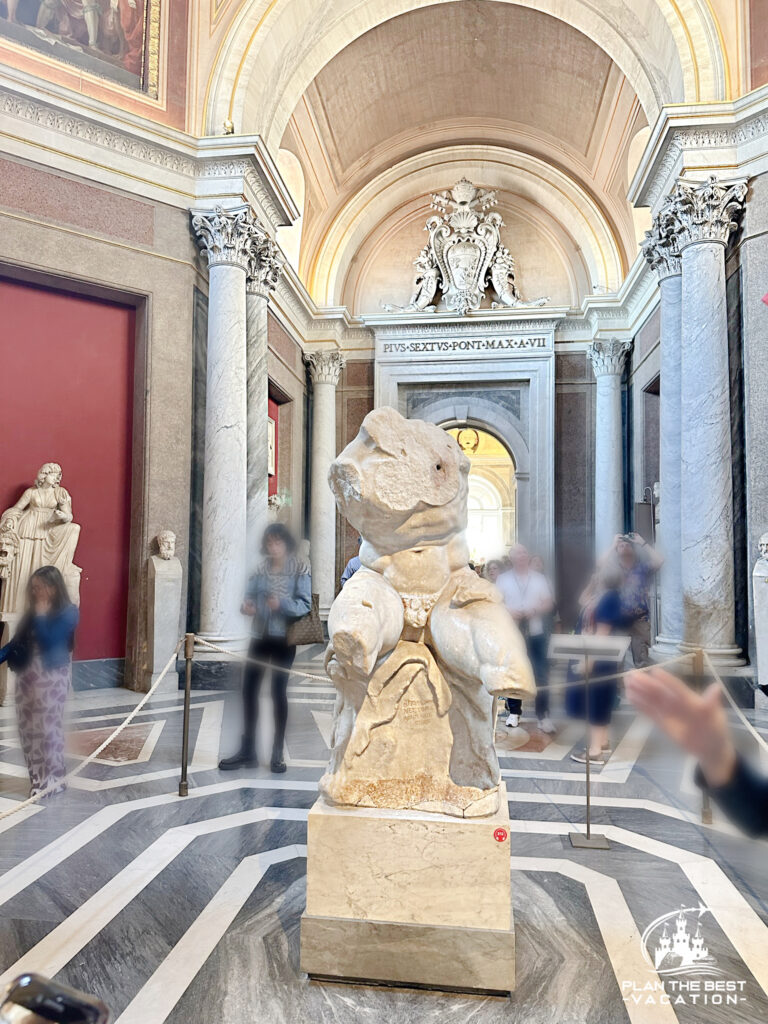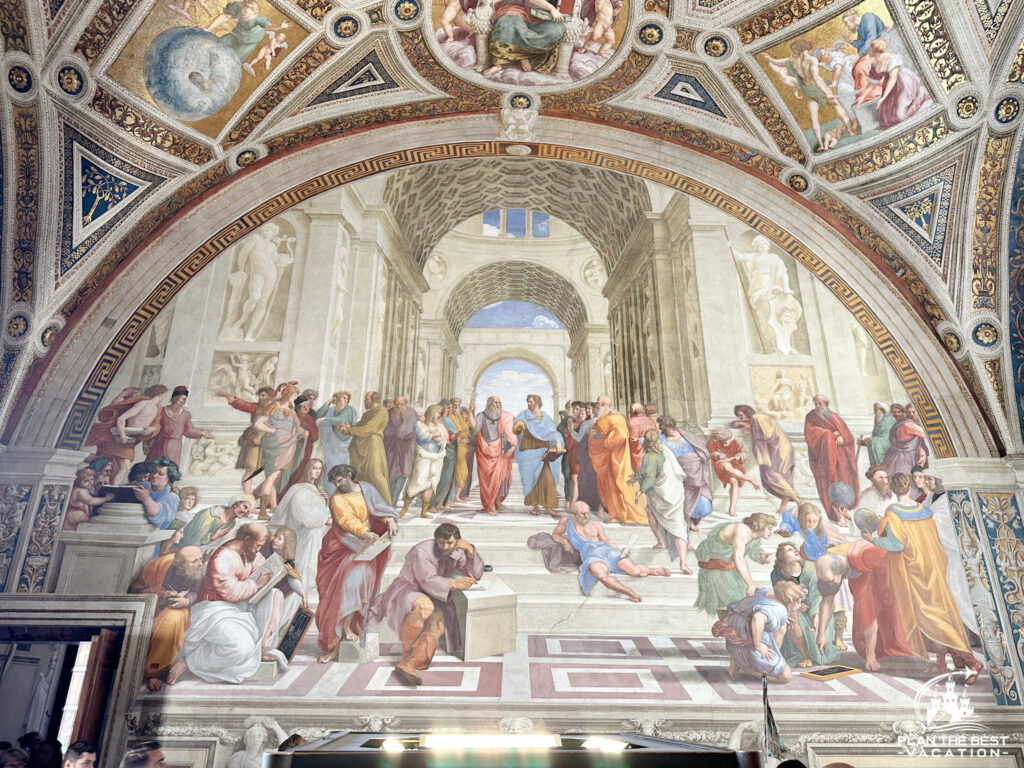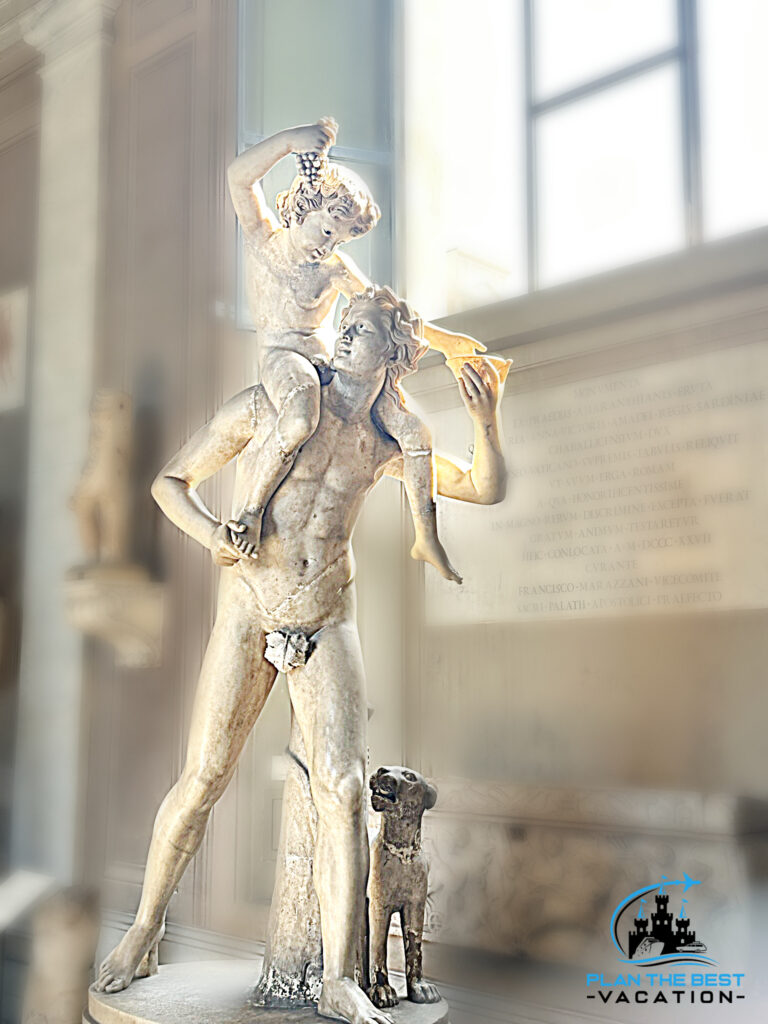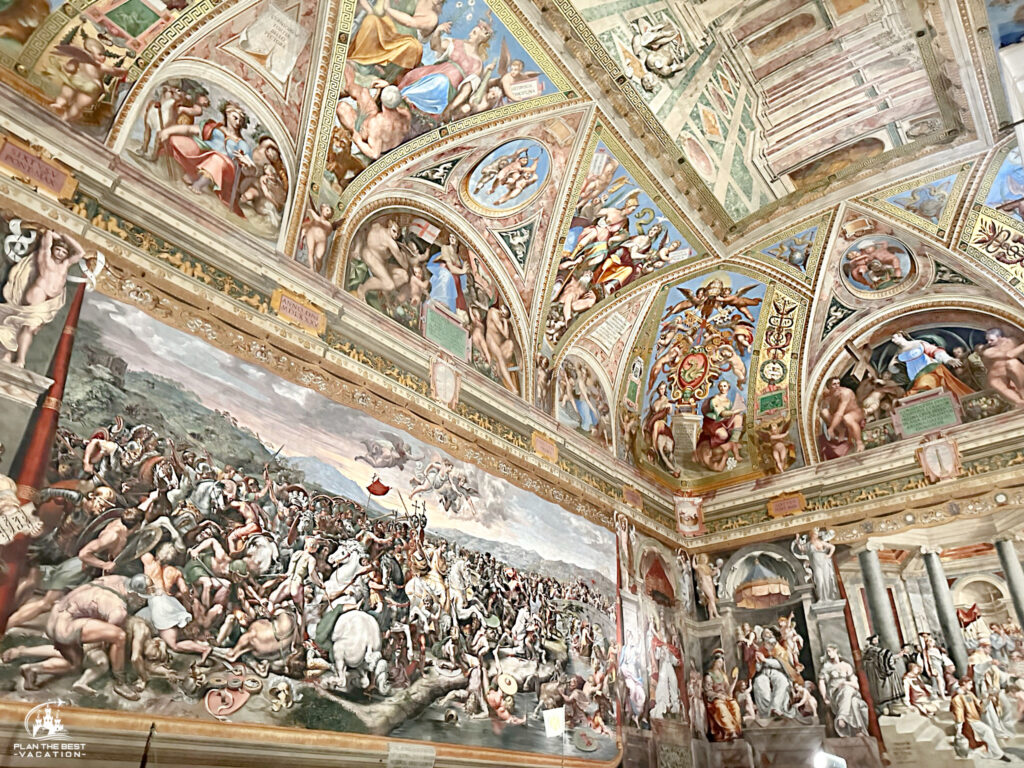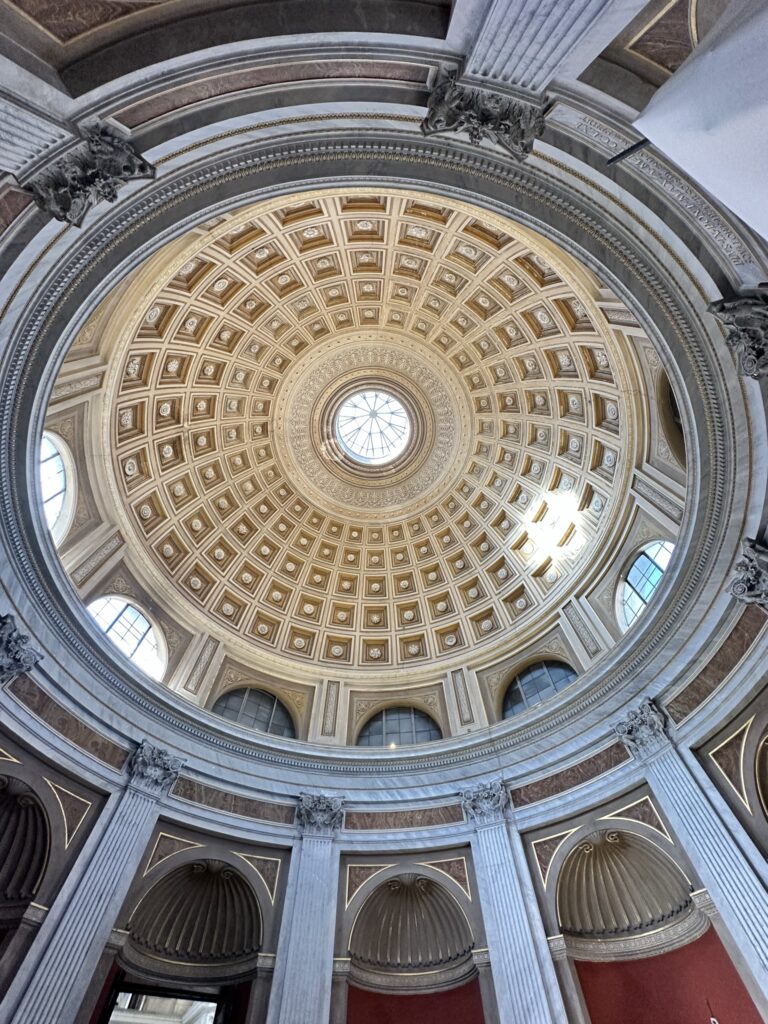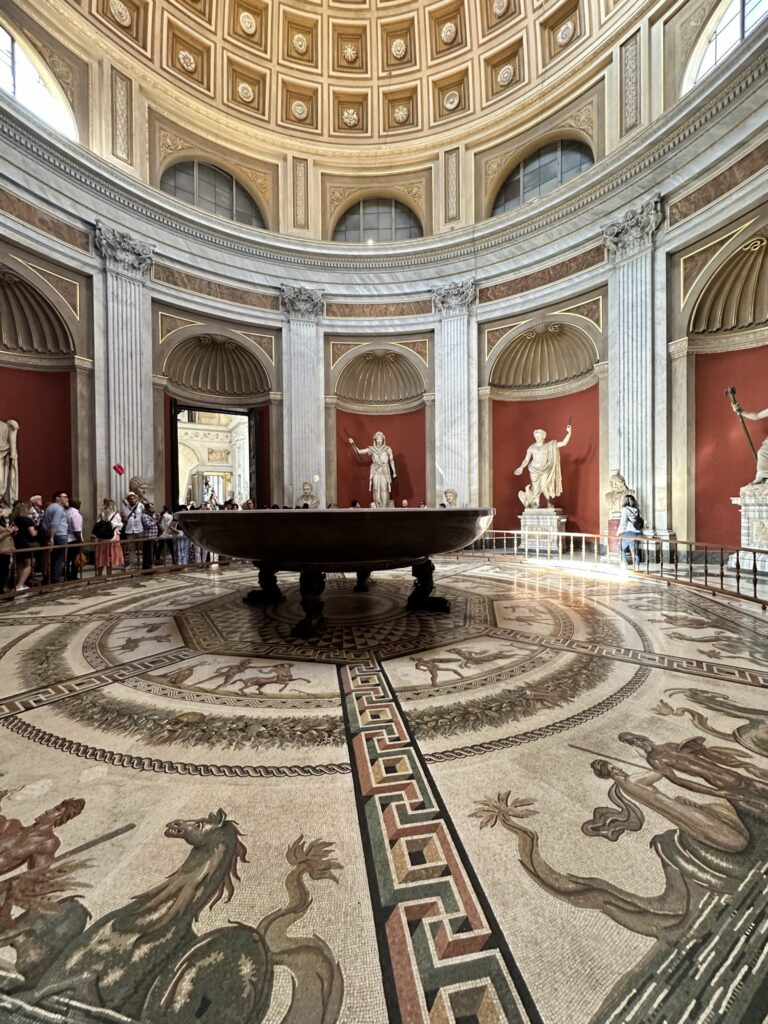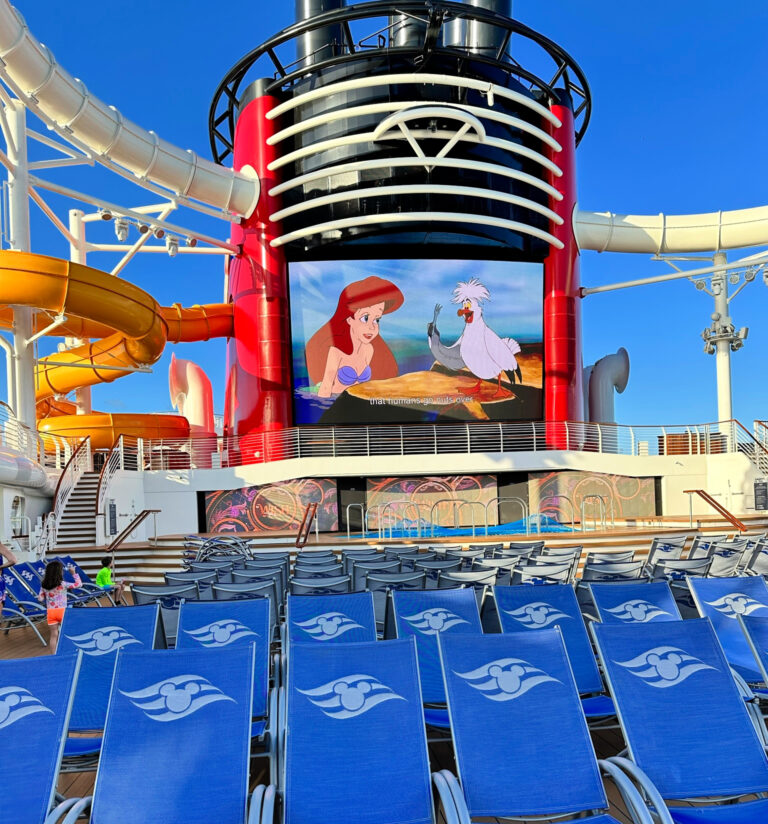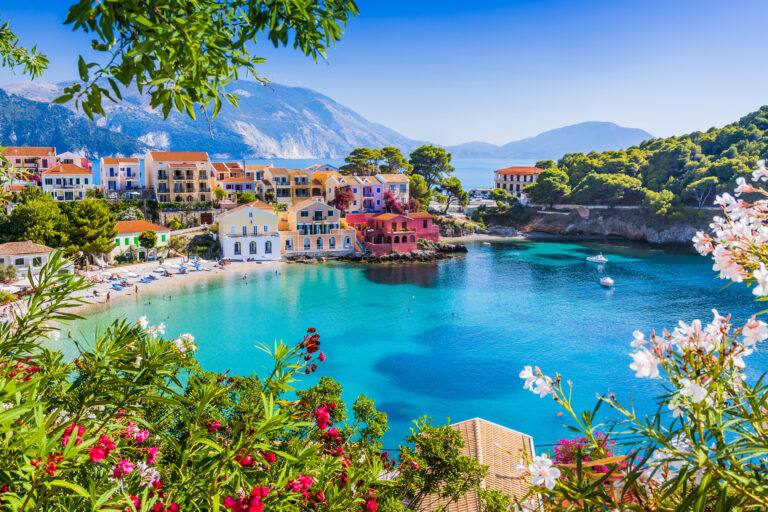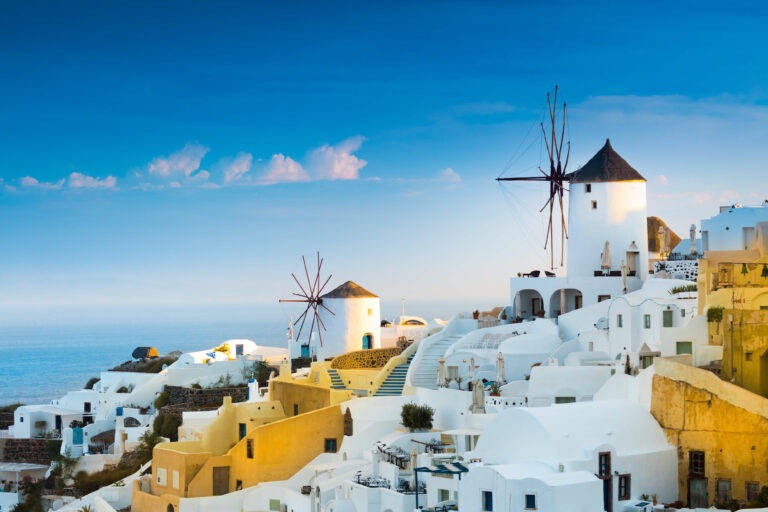What to See in Rome – 2-3 Day Itinerary
Embarking on a whirlwind 3-day trip to Rome is an adventure you won’t soon forget! Visit ancient ruins such as the Colosseum and Roman Forum. Plus don’t forget to make a wish as you toss a coin in the famous Trevi Fountain. Experience the history and beauty of these iconic landmarks, with some fun gelato breaks in the mixpanoramic views of !
Make sure to visit Vatican City and be amazed by the beautiful artwork in the Vatican Museum, like Michaelangelo’s Sisteen Chapel, plus exploring St. Peter’s Basilica. Rome truly is a must-visit city. Let me tell you what to see in Rome Italy with a handy itinerary for the whole family!
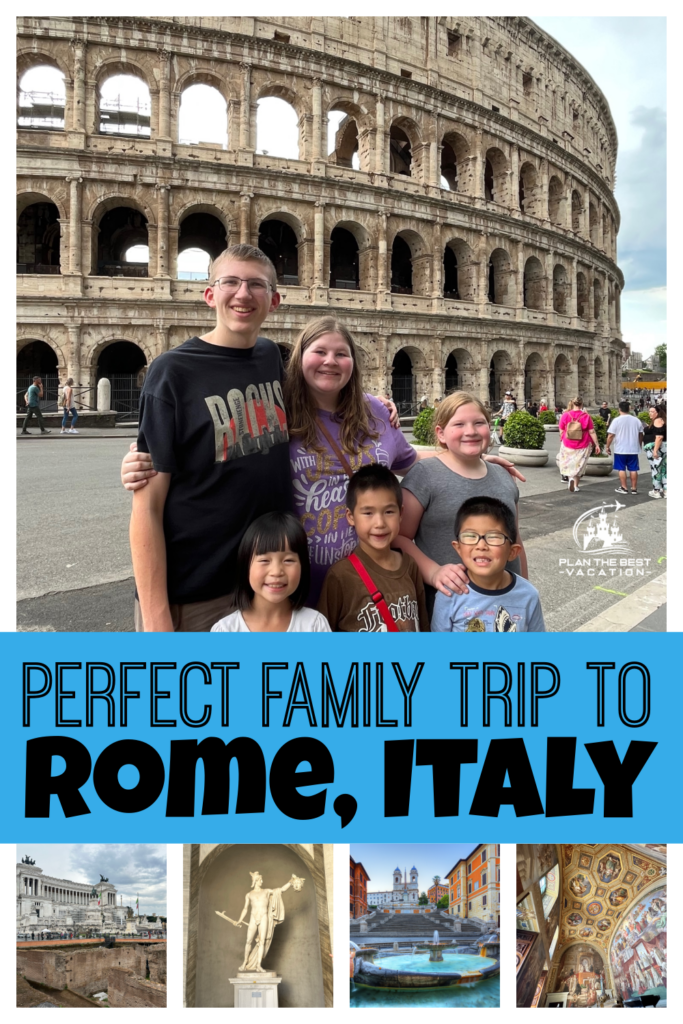
What to See in Rome
Seeing Rome in 3 days will keep you busy, but it is doable. You will hit the ground running and visit the Colosseium, Roman Forum, and Palatine Hill in 3-4 hours. Then walk over to the beautiful Baths of Carcalla. On the second day of the tour, you will go to the outskirts of the city. There, you will explore the famous catacombs, Roman Road, and a section of a renowned Roman aqueduct.
On the afternoon of your second day, you will visit famous monuments. These include the Trevi Fountain, Parthenon, Piazza del Popolo, Spanish Steps, Piazza del Rotonda, Piazza Navona, and Campo de Fiori. You will be busy exploring these iconic landmarks. Don’t worry, there is always time to stop for Gelato! You can spend the third day diving into other site, but I prefer to head out of the city on a tour of Pompeii and the Amalfi Coast.
As you get ready to head out of Rome, your last stop will be to the Vatican City where you will marvel at St Peter’s Basillica and the vast amounts of sculpture, tapestry, maps, and paintings including Raphaels’ School of Athens, Michaelangelos’ Sisteen Chapel, and others. In the afternoon it is time to move on to the next city.
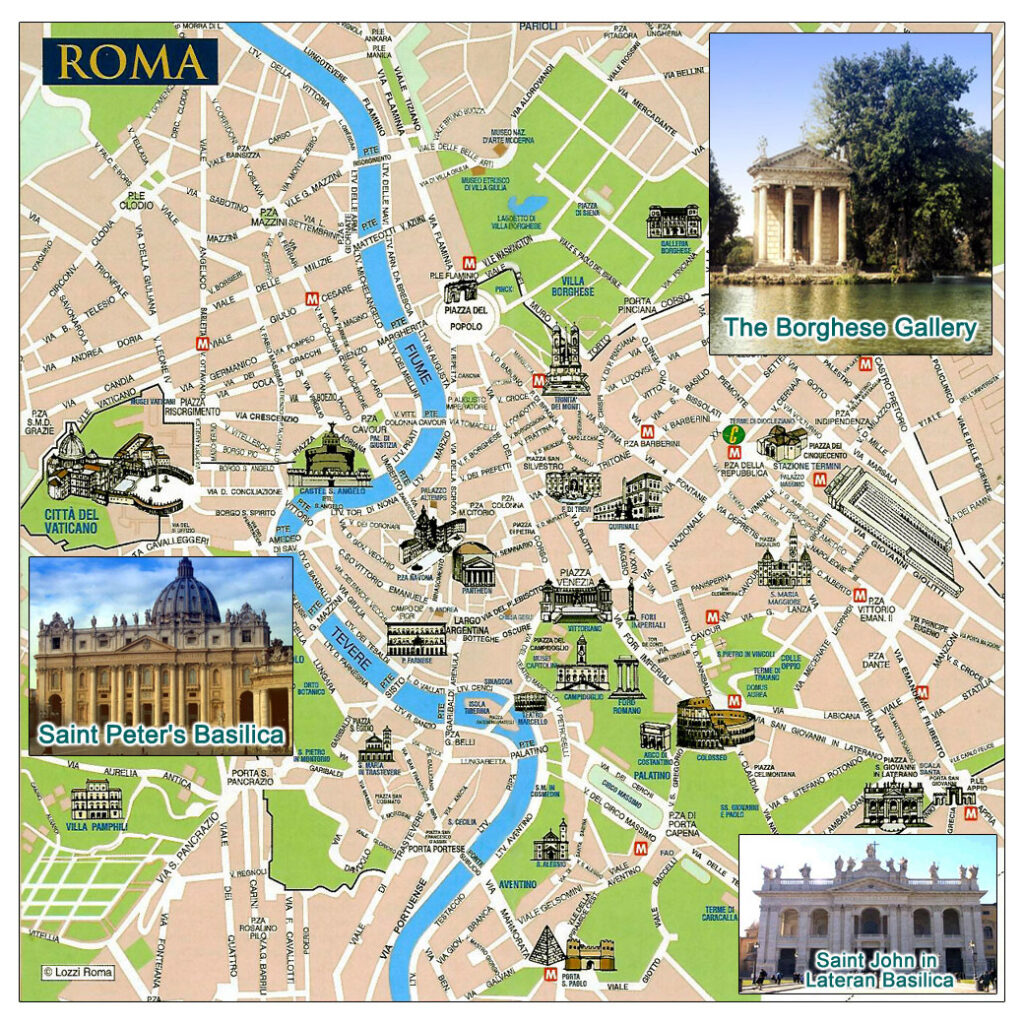
What to See in Rome Italy
There are tours for everything if you are more comfortable with that, but we liked to do some things on our own and others with a tour. This allowed us to learn the history, but still have time to go at our own pace. Plus it allowed us to save money too!
What to see in rome in 2 days
Because we don’t have endless time or resources, you probably wont be able to see everything! So here is what I would see if you have a limited time in Rome. Personally, we spent a week in Italy which included 2 days in Rome, 1 day in nearby Pompeii / the Amalfi Coast, and a morning seeing the Vatican City before heading onto Florence.
There are tours for everything if you are more comfortable with that, but we liked to do some things on our own and others with a tour. This allowed us to learn the history, but still have time to go at our own pace. Plus it allowed us to save money too!
Arriving in Rome
Whether you fly in to the ROM airport and take the Leonardo Express train into the city or arrive by train from another province, you will arrive in the Rome Termini Station. From there I suggest you stay in a hotel within walking distance. It will make it so much easier coming and going!
Look on Expedia around Rome Termini for hotel options that appeal to you. Some hotel options near Termini Train Station
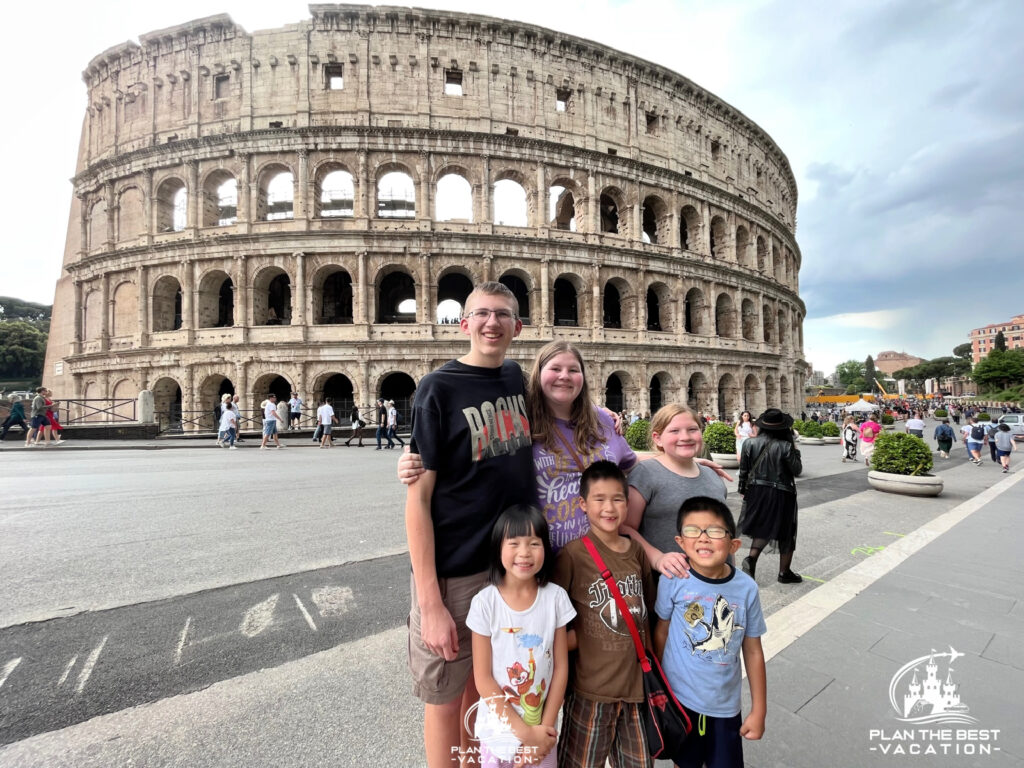
Day 1 – Colosseum, Roman Forum, Palatine Hill, and Baths of Carcalla
I recommend arriving in the morning so you can check into your hotel and start exploring the city by lunchtime!” Make sure you keep busy to not only maximize your time in this incredible city, but it will also help you get over jetlag easiest!
I suggest starting your sightseeing in Rome at the Colosseum, Roman Forum, and Palatine Hill. These are some of Italy’s most famous historical landmarks. The coloseum is, after all, one of the New Seven Wonders of the World! We walked from our hotel.
I suggest you book a tour to see the Colosseum, Roman Forum, and Palatine Hill. By using it, you can save time waiting in line and gain valuable historical information to better understand this amazing site. Tours usually last 3-4 hours and meet nearby. Here is the tour we took and loved.
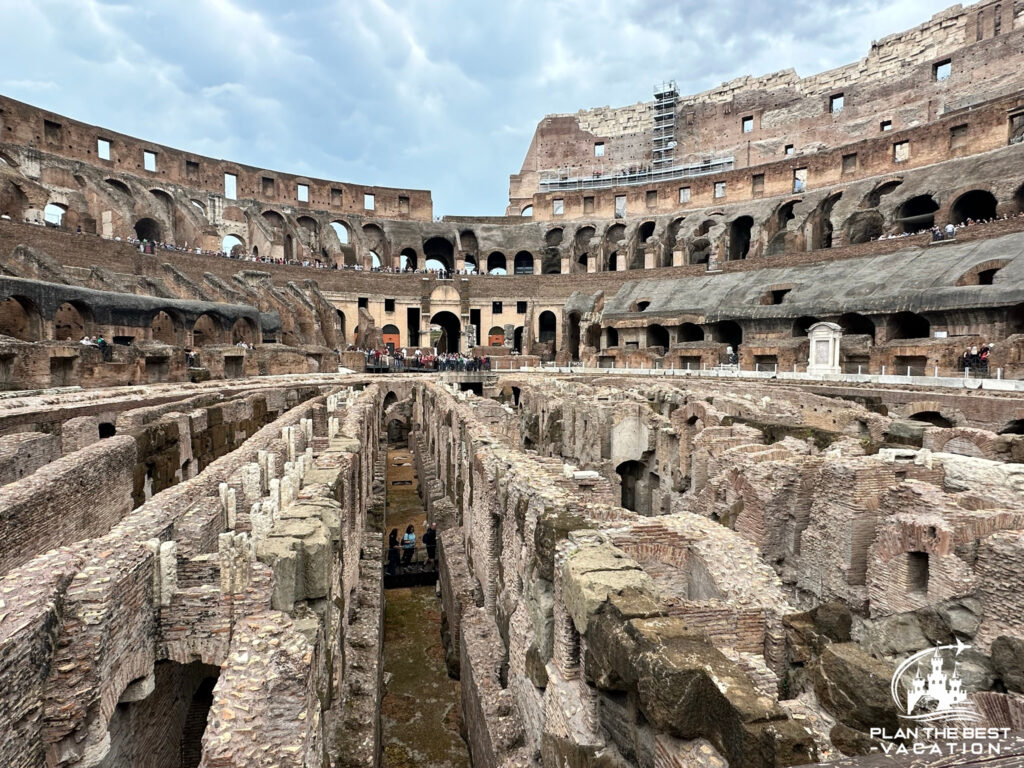
Roman Colosseum
The Colosseum was built more than 2,000 years ago. It was used for gladiator fights, animal hunts, and other entertainment for the ancient Romans. It could hold up to 80,000 spectators and was an impressive feat of engineering for its time. The Colosseum in Rome is one of Rome’s most popular tourist attractions and a symbol of the power and grandeur of the Roman Empire.
Note: You can also take a special tour to go down in the tunnels.
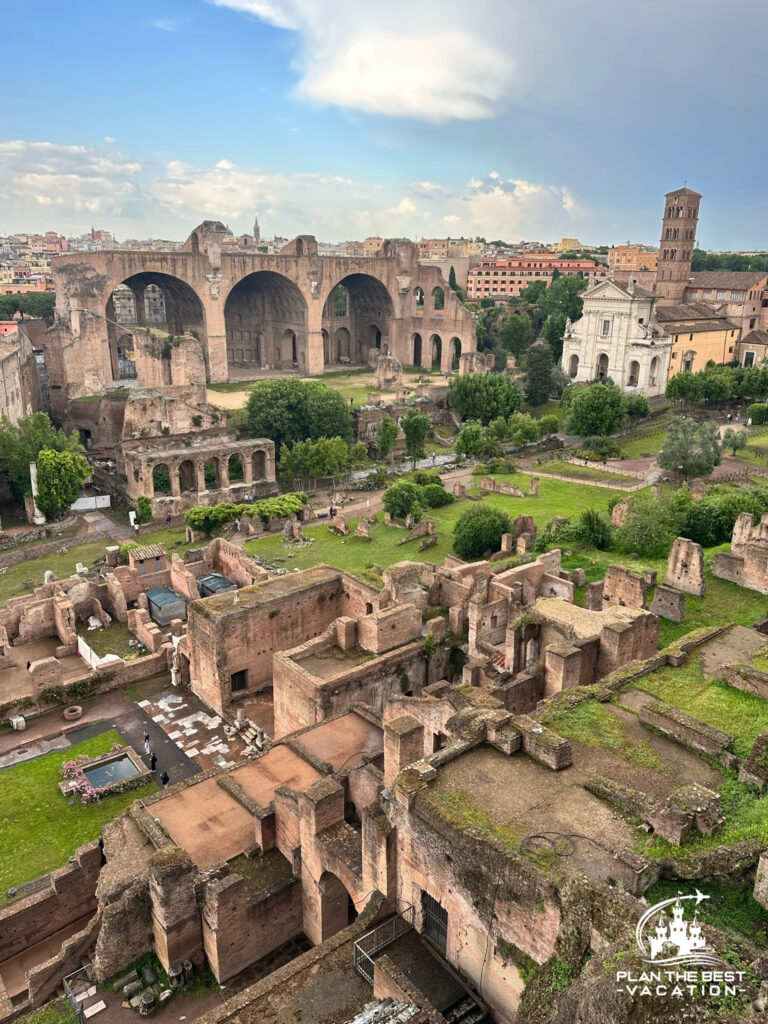
Roman Forum
The Roman Forum, located nearby, was the bustling heart of ancient Rome. It served as a marketplace, political center, and gathering place for citizens to discuss politics, trade goods, and worship their gods. Today, visitors can see the remains of temples, basilicas, and government buildings. These structures were once part of a vibrant center of activity.
Palatine Hill is close by. It is the most central of Rome’s seven hills. It was where the imperial palaces of Rome’s emperors were located. You can see beautiful views of the Roman Forum and the Circus Maximus from here. Visitors can also walk around the old palaces and gardens that used to be on this hill.”
NOTE: With limited time in Rome you probably won’t have time to visit Circus Maximus.
Next, take a walk to see the Baths of Carcalla that are an easy 15 minute walk from here. You will walk past the Circus Maximus. I suggest you view this on your own to save money/time. It took us 1-2 hours to enjoy at a leisurely pace.
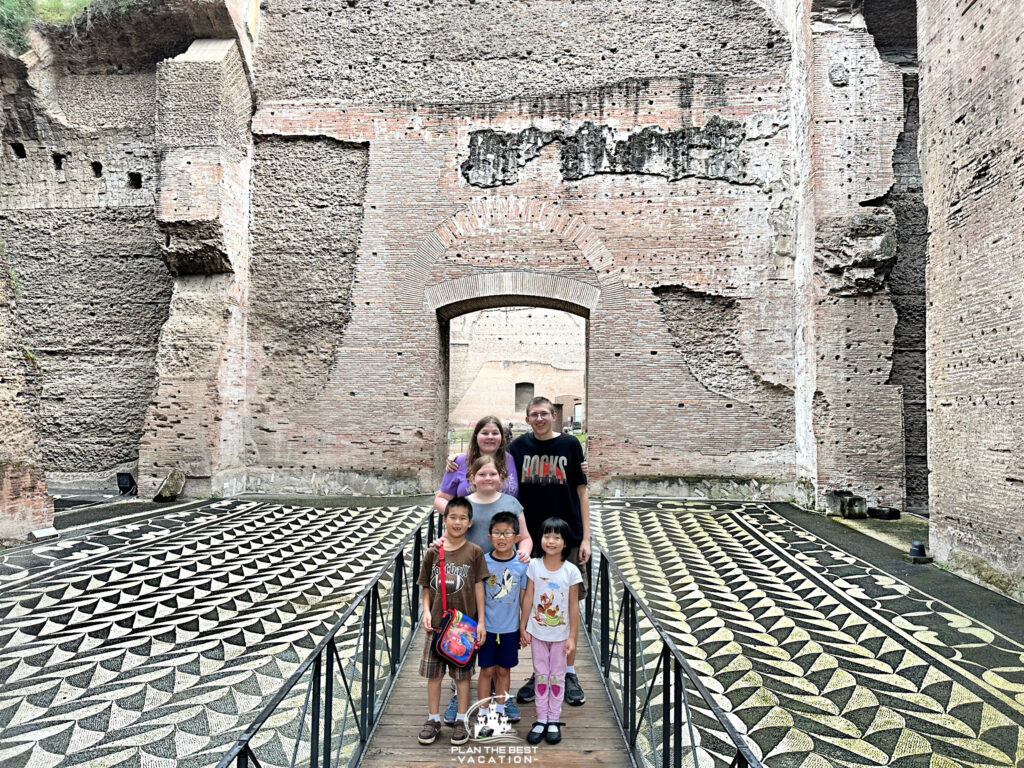
Baths of Carcalla
When you go to the Baths of Caracalla, you’re not just learning history. You’re actually going back in time to the height of Roman civilization. Step back in time as you wander through the well-preserved ruins, marveling at the grandeur and scale of this once lavish complex. Signs will walk you through what everything is, its purpose, and what it once looked like.
What are Roman Baths?
Picture a stunning building where individuals can relax in hot pools, receive massages, work out, and mingle with friends. The Roman baths were not just about getting clean – they were a place for people to unwind and have fun, too.
When ancient Romans visited a Roman bath, they would start by sweating it out in a hot room called the caldarium. Then, you would move to the lukewarm tepidarium, followed by a refreshing dip in the frigidarium. After that, you could enjoy some time in the steamy sauna called the sudatorium. The Roman baths were an important part of Roman society. They were luxurious and served as a place for people to relax. The baths were accessible to everyone in the town. It was a popular spot for people to unwind and socialize.
Day 2 – Catacombs, Appian Way, Aqueduct, Squares, Monuments & Fountains
Start your second day in Rome by grabbing a cappuccino and embarking on a tour of the catacombs and Roman countryside. Walk along the Apian Way and marvel at a Roman aqueduct during this unforgettable experience. Here is the tour we took.

What are Roman Catacombs
Early Christians in Rome used Roman catacombs as ancient underground burial sites. The catacombs were used by Christians for burying their dead. They were also used as hiding spots and meeting places for persecuted believers during times of religious persecution.
The catacombs contain a network of tunnels and chambers lined with graves where people laid the deceased to rest. Some catacombs have paintings, statues, and writings that show what early Christians believed and did.
Visiting the Roman catacombs is like taking a journey through time, immersing yourself in a captivating and moving piece of history. The underground burial grounds show the faith and strength of early Christians, as well as ancient art and architecture.
Exploring the Roman catacombs gives us a special look into the lives and beliefs of people from the past. It is a must-see destination for history buffs, art enthusiasts, and anyone interested in learning more about the rich cultural heritage of Rome.
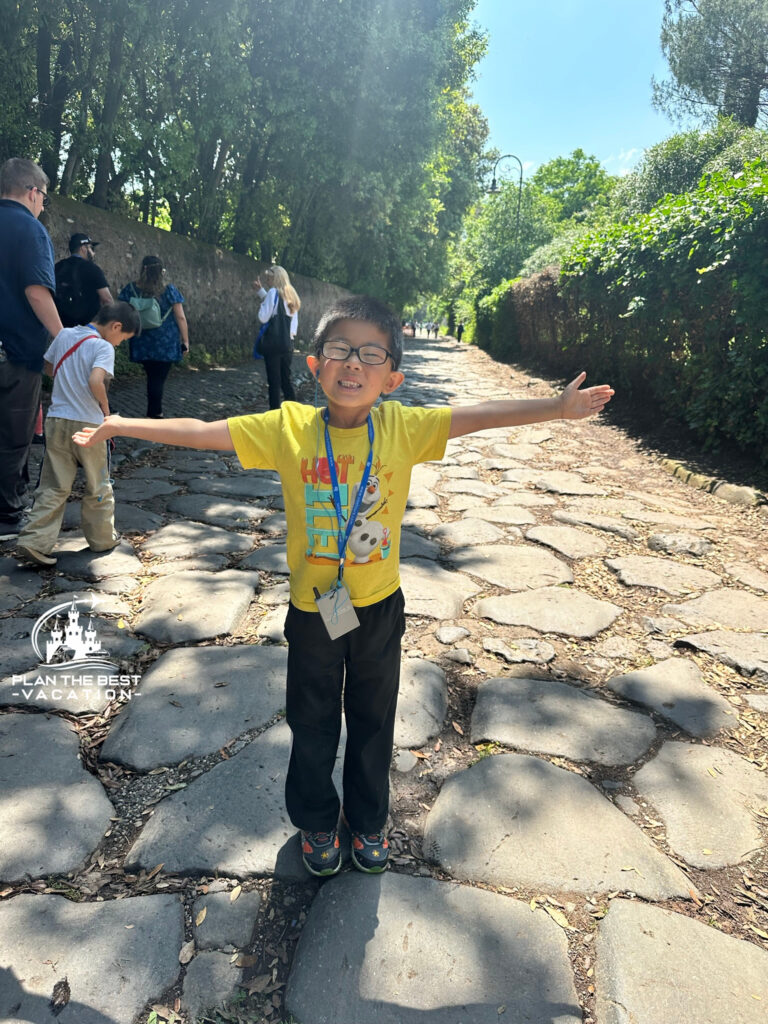
What is the Appian Way
The Appian Way, also known as Via Appia, is one of the most ancient and important roads of ancient Rome. The Appian Way, stretching from Rome to Brindisi in southeastern Italy, was the first long road constructed for military use. It enabled the Roman army to swiftly transport troops and supplies to various regions of Italy and beyond.
The Appian Way was named after Roman censor Appius Claudius Caecus. He started building it in 312 BC. The road was instrumental in the growth and power of the Roman Empire. Throughout history, the road was important for military campaigns, trade, and communication. It connected Rome to key cities and ports.
Today, lots of tourists go to the Appian Way. They walk on the old cobblestones and see ancient ruins and archaeological sites along the road. This gives us a peek into the past and shows how skilled the Romans were at engineering and organizing.
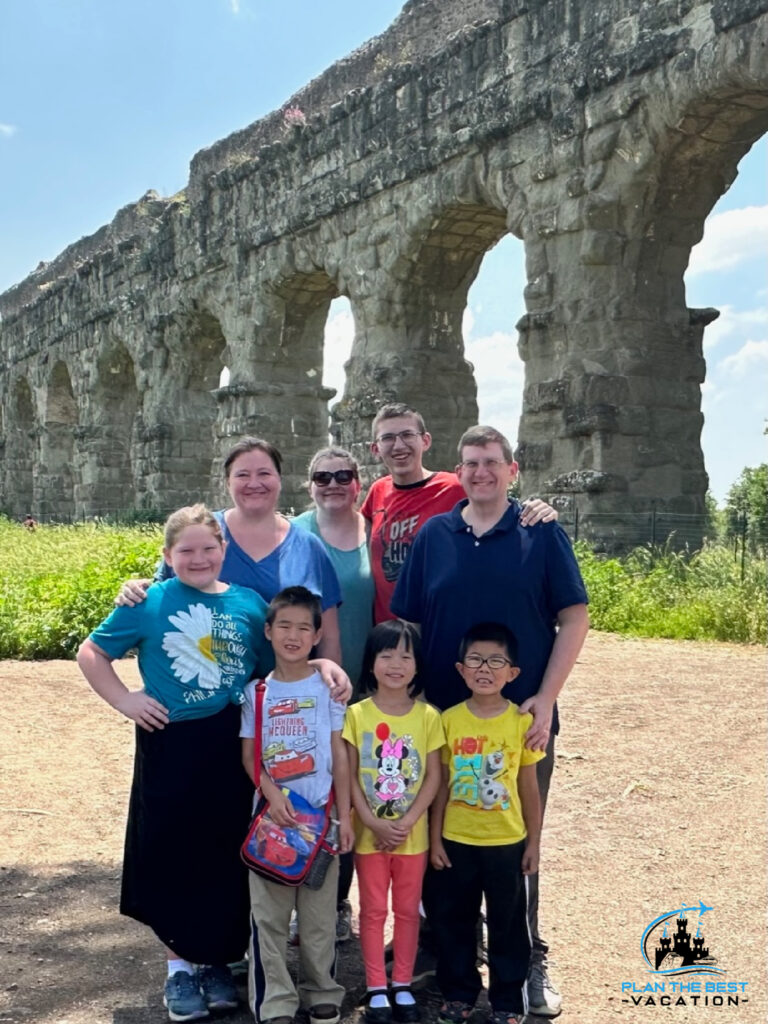
What is a Roman Aqueduct
Roman aqueducts were magnificent structures built by the ancient Romans to transport water across vast distances. The aqueducts played a crucial role in Roman society by supplying water to cities, public baths, and even some private residences. The Roman aqueduct system was built with arches, tunnels, and channels. These structures transported water from sources such as springs or rivers. The water was delivered to cities that required it. The sheer engineering prowess required to construct these aqueducts is truly awe-inspiring, especially considering they were built over 2,000 years ago.
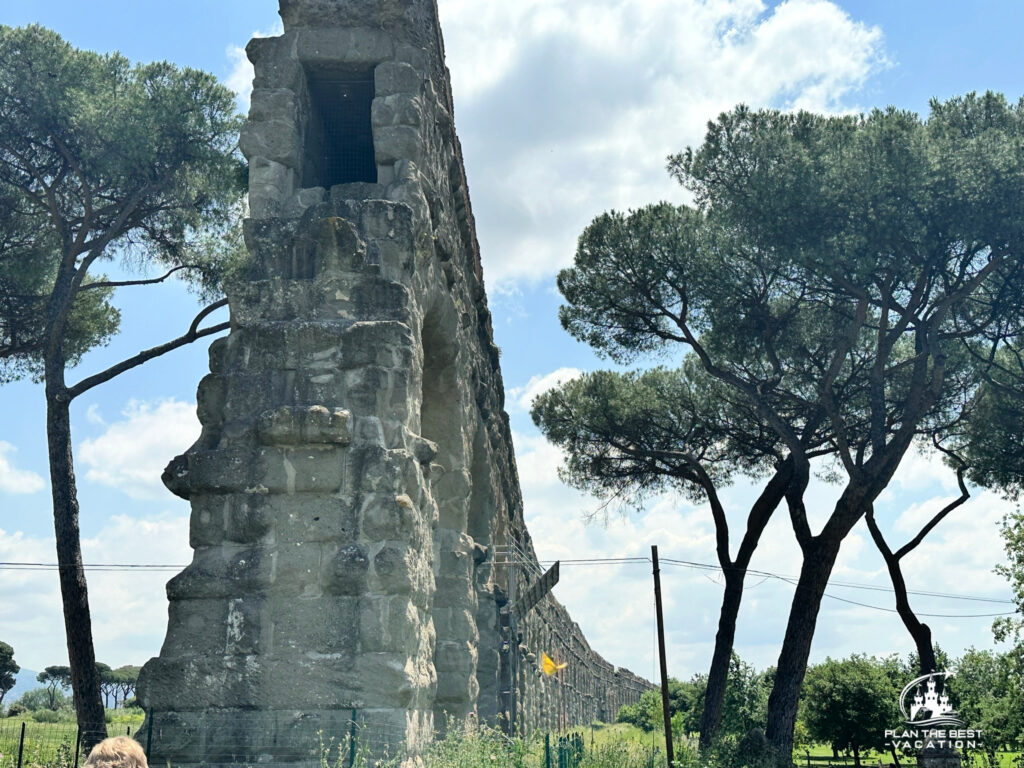
The Roman aqueduct system was a testament to the ingenuity and skill of the ancient Romans, showcasing their ability to harness nature for the benefit of society. Today, these structures not only serve as a reminder of the incredible feats achieved by one of the greatest civilizations in history, but still provide water to power the famous, beautiful Trevi Fountain you will see this afternoon.
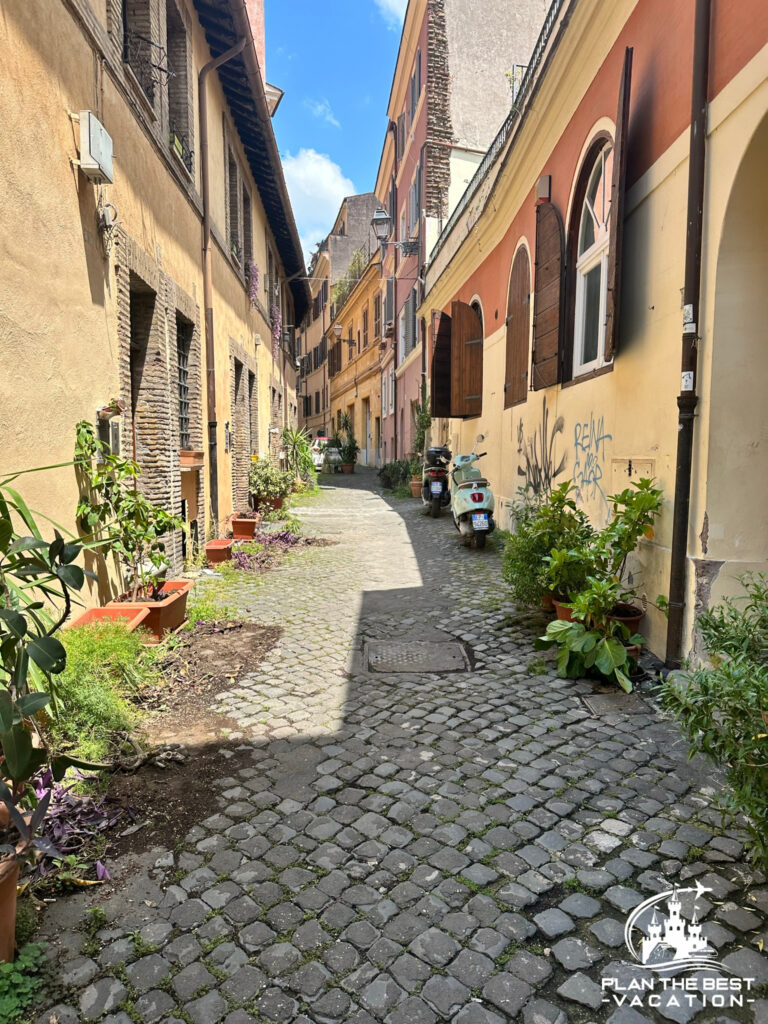
In the afternoon you get the chance to wander through historic Rome, explorig various monuments, statues, and fountains that many only dream of seeing. Use your map (on your phone, here, or one your hotel will gladly give tourists for free) to pick the route that looks good to you. Feel free to grab lunch and gelaton on your way from some place that looks yummy to you! Here is what you should make sure to see:
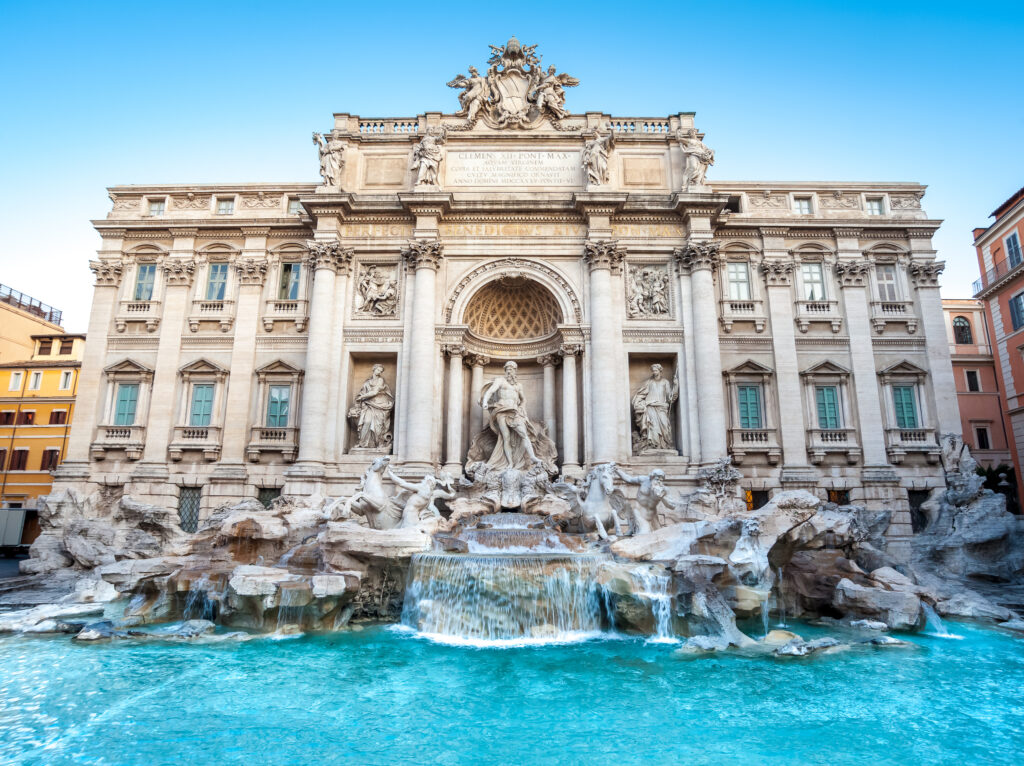
Trevi Fountain
The Trevi Fountain is an ornate sculputre and fountain all in one. This tucked away landmark is an iconic fountain located in Rome, Italy.
The Trevi fountian was designed by architect Nicola Salvi in the 18th century. This impressive design is the largest Baroque fountain in the city and one of the most famous fountains in the world. Not surprisingly, millions of tourists visit every year. Many guests toss a coin into the water as superstition, thinking it will bring them good luck and make them return to Rome someday.
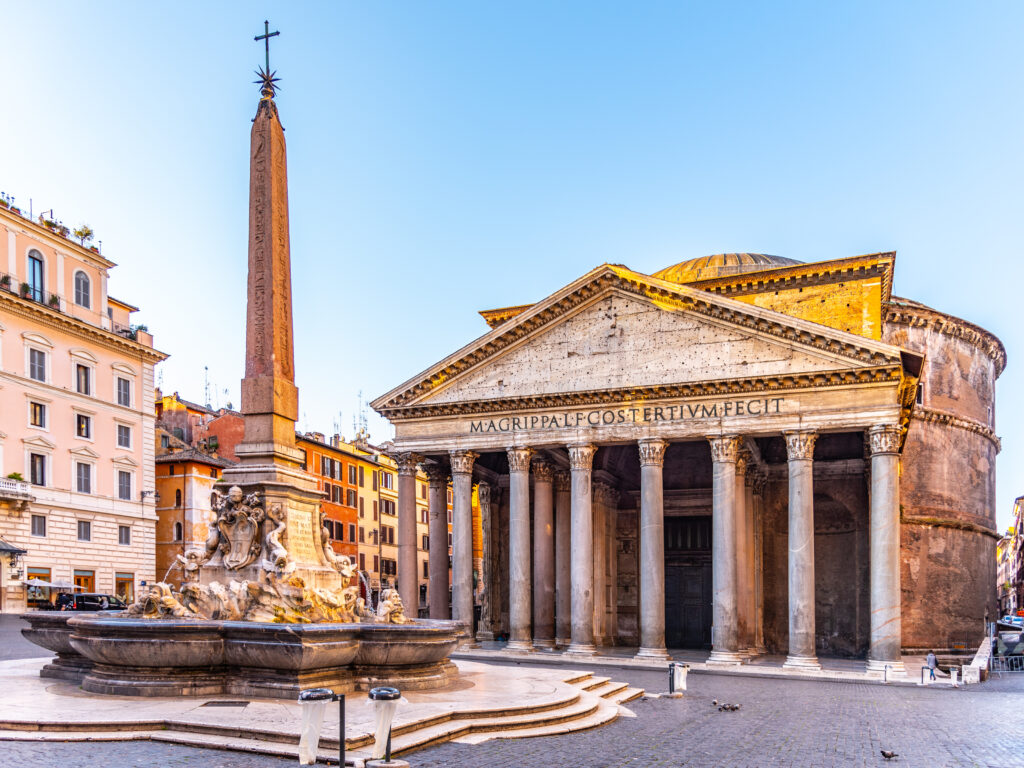
Piazza del Rotonda
It is most well-known for being home to the iconic Pantheon, one of the best-preserved ancient Roman buildings. Cute cafes, restaurants, and shops surround the square, making it a busy place for both locals and tourists.
Parthenon
The Parthenon in Rome is also known as the Pantheon. It is an ancient temple that showcases the impressive architecture of the Roman Empire. Built nearly 2,000 years ago, this iconic structure has stood the test of time and continues to amaze visitors with its grandeur and beauty.
If you’re into history, architecture, or just amazed by human accomplishments, you have to visit the Parthenon. The intricate detailing in the design, the massive dome, and the oculus at the center all come together to create a sense of awe and wonder.
Not only is the Parthenon a visually stunning masterpiece, but it also holds great historical significance. Originally built as a temple to the Roman gods, it later served as a church and eventually a mausoleum for important figures in Roman history. Walking through its hallowed halls, you can feel the weight of centuries of history and culture.
You will need tickets to go inside Parthenon, but they are only 5 Euros each.

Piazza del Popolo
Piazza del Popolo is one of the most iconic squares in Rome, Italy. It stands at the northern end of Via del Corso and is renowned for its grandeur and beauty. Magnificent churches, fountains, and statues line the square, making it a popular spot for both tourists and locals.
In the middle of Piazza del Popolo, there is an ancient Egyptian obelisk. It was brought to Rome in ancient times and re-erected in the square during the 16th century. This tall monument makes the square look even more impressive and reminds people of Rome’s long history.”
Surrounding the square are three churches: Santa Maria del Popolo, Santa Maria dei Miracoli, and Santa Maria in Montesanto. Each of these churches boasts stunning architecture and important works of art, making them must-see attractions for visitors to the square.
Piazza del Popolo is not only a beautiful square but also a hub of activity. It is a popular meeting spot for locals, a venue for events and concerts, and a great place to relax and people-watch.
HINT: We met here for our day trip from Rome tour, so check your meeting place because you may be here a different day!
Pincio Terrace
Pincio Terrace, also known as Terraza del Pincio, is a stunning viewpoint located in the heart of Rome, Italy. Situated on the Pincian Hill, this terrace offers breathtaking views of the Eternal City, including famous landmarks such as St. Peter’s Basilica, the Spanish Steps, and the Tiber River. It is a popular spot for locals and tourists alike to enjoy a leisurely stroll, take in the beautiful scenery, and capture memorable photos of Rome’s iconic skyline.
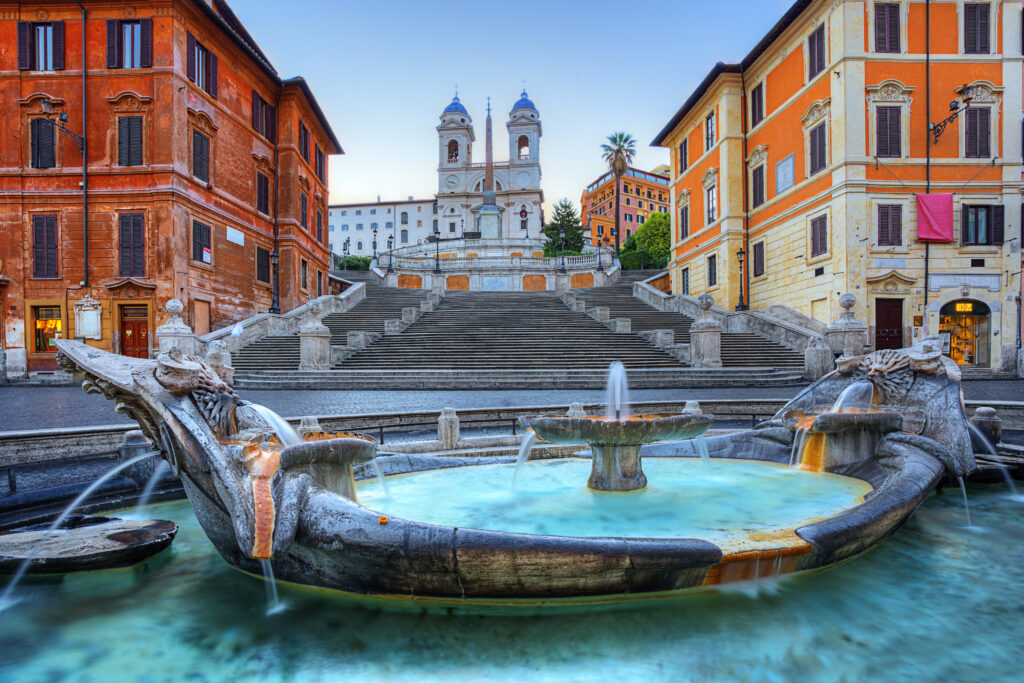
Spanish Steps
The Spanish Steps are yet another famous landmark in Rome. The picturesque area includes a fountain at the base i what is known as the Piazza di Spagna (or Spanish Plaza) and 135 stairs leading up to Trinità dei Monti church at the top. This Baroque architecture is not only a beautiful historical area, but a popular hangout for loals and tourists alike.
NOTE: They no longer allow people to sit on the steps, guards will insist you move.
Fontana della Barcaccia
Fontana della Barcaccia is a stunning Baroque fountain in the center of the city of Rome. This fountain was designed by Pietro Bernini and his son Gian Lorenzo Bernini. The fountain takes the shape of a sinking boat, or “barcaccia” in Italian, which was inspired by a flooded boat that washed up on the banks of the Tiber River during a historic flood. This unique and intricate design symbolizes the resilience of the Roman people in the face of natural disasters. It also reminds Romans of the city’s connection to water.
Visitors to Rome often marvel at the Fontana della Barcaccia, which sits at the foot of the famous Spanish Steps and is a popular spot for both locals and tourists to gather and relax. The soothing sound of water flowing from the fountain’s ornate spouts provides a peaceful backdrop for enjoying the beauty of the surrounding Piazza di Spagna.
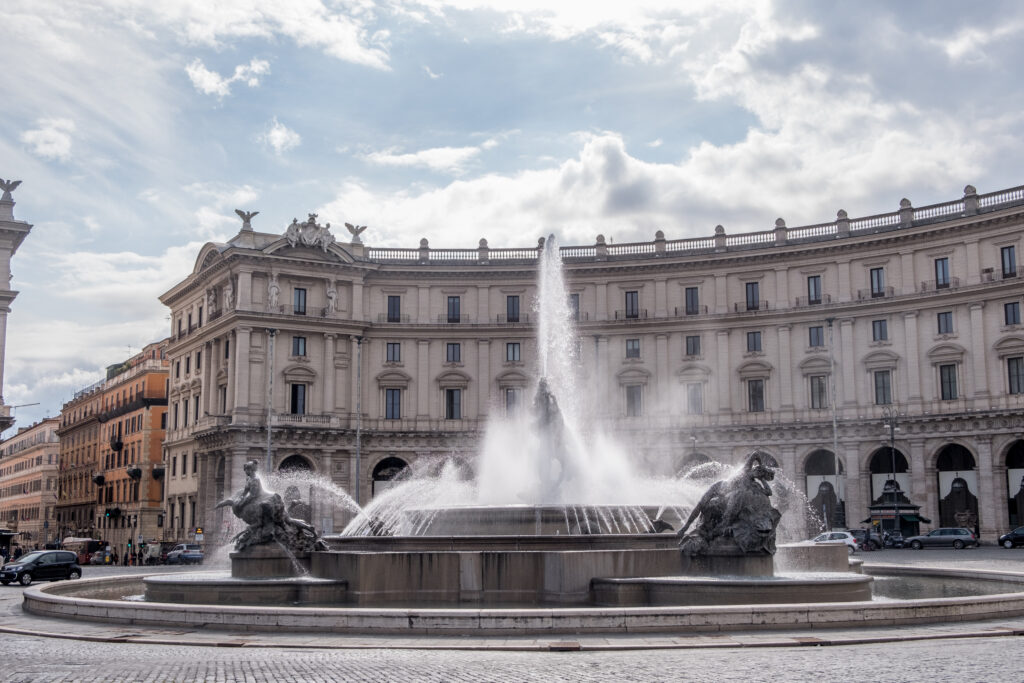
Piazza Navona
This plaza was origianlly built as a stadium in the 1st century, but is now home to three beautiful fountains including the famous Fountain of the Four Rivers designed by Gian Lorenzo Bernini. The square is also lined with charming cafes, restaurants, and shops, making it a vibrant hub of activity day and night.
Campo de Fiori
Translating to “Field of Flowers,” this historic square has a rich history dating back to the Middle Ages. Once a meadow where flowers were sold, Campo de Fiori is now home to a daily market selling fresh produce, flowers, and local goods. Surrounded by beautiful Baroque architecture and lined with charming cafes and restaurants, Campo de Fiori is a favorite spot for locals and tourists alike. At night, the square transforms into a lively gathering place with street performers, musicians, and lively atmosphere that attracts people from all walks of life. The centerpiece of Campo de Fiori is the statue of Giordano Bruno, a philosopher who was burned at the stake for his beliefs in the 16th century. This statue serves as a reminder of the square’s tumultuous past and adds to its unique character.
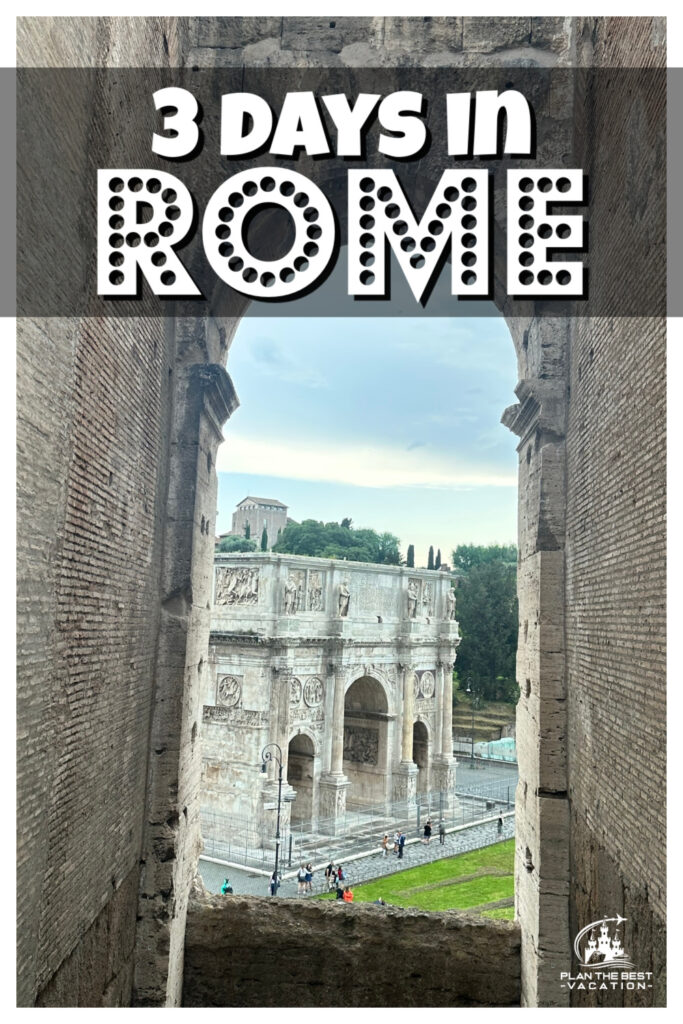
What to see in rome in 3 days
If you have the chance to spend a third day in Rome you must visit the Vatican City! The Vatican City is a unique city-state located within the city of Rome, Italy. It is the smallest country in the world both in terms of size and population. The Vatican is not only the spiritual center of the Roman Catholic Church but also serves as the residence of the Pope, the leader of the Catholic Church. Within the walls of Vatican City, visitors can explore iconic landmarks such as St. Peter’s Basilica, the Sistine Chapel, and the Vatican Museums which house an impressive collection of art and artifacts. The Vatican is also a UNESCO World Heritage Site, recognized for its cultural and historical significance.
I highly recommend taking a guided tour of the Vatican City. There is just so much to see you could miss some really amazing masterpieces because you are looking at all the other lovely pieces. Not only will a guide whisk you from the best pieces to the next best piece, they will give you so much intersting information to help you make the most of your visit. You will need at least 4 hours for your tour. Here is the tour we took and loved!
Vatican Museum
Here are some of the amazing things you can see on your visit:
- The Sistine Chapel – Marvel at the iconic ceiling painted by Michelangelo, including the famous fresco of The Creation of Adam.
- The Raphael Rooms – Admire the beautiful frescoes painted by Raphael, one of the greatest artists of the Italian Renaissance.
- The Gallery of Maps – Explore a corridor adorned with stunning maps of Italy painted in the 16th century.
- The Belvedere Courtyard – Step outside to see ancient sculptures in a picturesque courtyard setting.
- The Stanze di Raffaello – Visit the papal apartments adorned with frescoes by Raphael.
- The Egyptian Museum – Discover an impressive collection of ancient Egyptian artifacts.
- The Gallery of Tapestries – Admire intricate tapestries from the 16th century.
- The Chiaramonti Museum – Explore a collection of Roman sculptures.
- The Pinacoteca – See a diverse collection of paintings from various periods.
- The Vatican Library – Learn about the history of the Vatican’s extensive book collection.
- The Gregorian Etruscan Museum – Discover artifacts from the ancient Etruscan civilization.
- The Hall of Busts – View a collection of Roman bust sculptures.
- The Vatican Gardens – Take a stroll through the serene gardens on a guided tour.
- The Gallery of the Candelabra – Admire a corridor lined with ancient Roman marble sculptures and candelabra.
- The Apostolic Palace – Visit the official residence of the Pope and the administrative center of the Vatican.
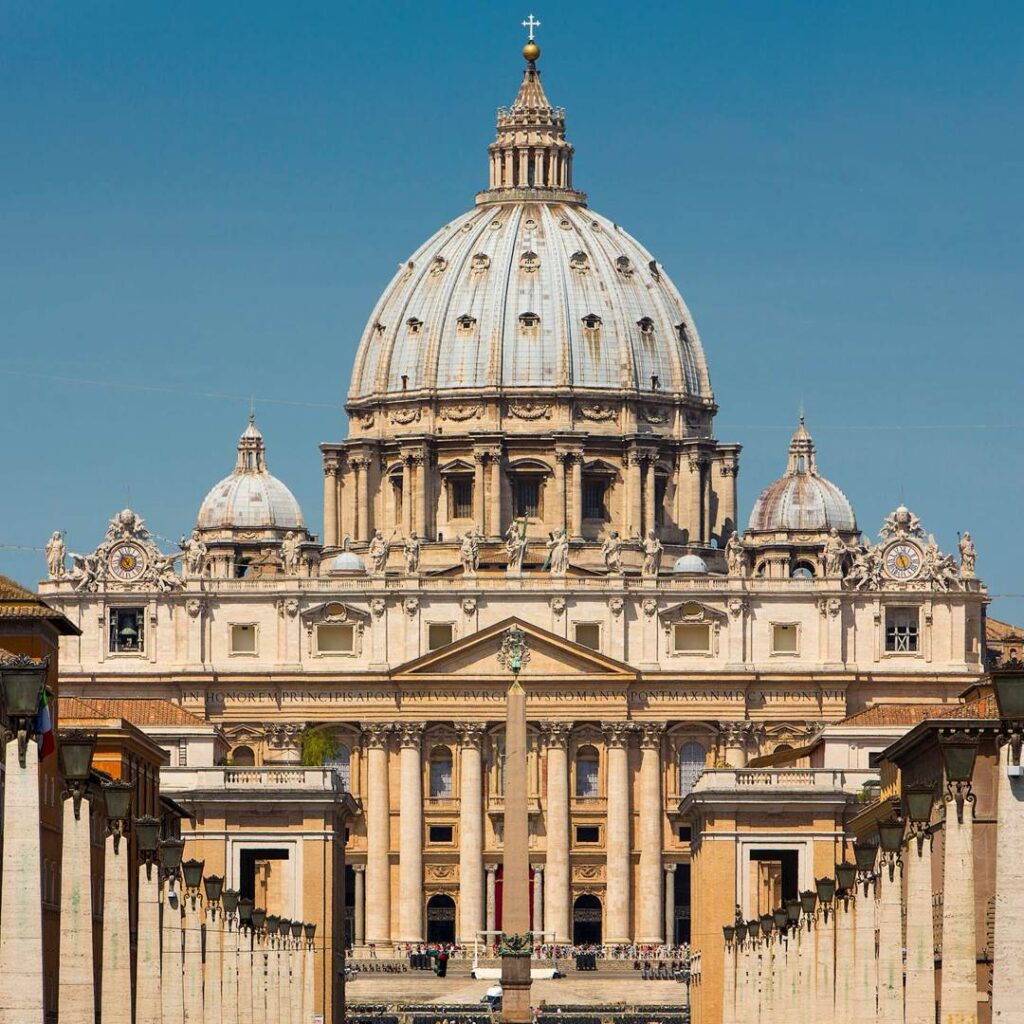
St Peter’s Basilica
Make sure you allow time to visit St. Peter’s Basilica is one of the most iconic and breathtaking churches in the world, located in Vatican City. This stunning architectural masterpiece was designed in the Renaissance style by some of the greatest artists and architects of the time, including Michelangelo. As the largest church in the world, St. Peter’s Basilica holds great significance for the Catholic Church and is considered one of the holiest shrines. Not only is it a place of worship, but it also serves as a popular tourist attraction drawing millions of visitors each year. The basilica is home to numerous works of art, including Michelangelo’s magnificent Pietà and Bernini’s impressive baldachin. The awe-inspiring dome, towering high above the city, offers panoramic views of Rome.
After you finish your visit I suggest you return to your hotel to retrieve your luggage from storage and head to the train station to get to your next city so you are ready to hit the ground running the following morning. You can look at all your pictures on your phone as you rest on the train ride.
Day trips from rome
If you can spare another day, making it 4 days in Rome, you really should! On day four you will do an amazing day trip from Rome! I’m a big fan of unpacking in one city and using it as a springboard for days. So I’d stay in the same hotel you did while touring Rome. But this post is already long….. so read all about our day trip we took from Rome on Day 4 here.
Don’t miss the rest of our 7 day Family Trip to Italy here! Including:
- What to See in Rome in 3 Days
- Pompeii Trip from Rome
- Rome to Amalfi Coast Day Trip
- What to See in Florence in One Day
- Day Trips from Florence
- What to See in Venice Italy
